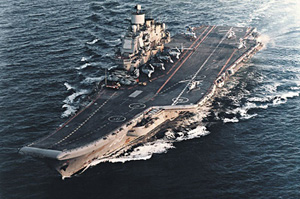| Tell a friend | Print version |
|---|
What future for carrier aviation?
Source: , author: RIA Novosti military commentator Ilya Kramnik Every time the heavy aircraft-carrying cruiser Admiral Kuznetsov sails to distant seas, it sparks a discussion on the future of aircraft carriers and their place in the Russian Navy. The latest sortie by Kuznetsov to the Mediterranean was no exception: on top of it all, it was marred by a fire aboard, in which a sailor died.
Every time the heavy aircraft-carrying cruiser Admiral Kuznetsov sails to distant seas, it sparks a discussion on the future of aircraft carriers and their place in the Russian Navy. The latest sortie by Kuznetsov to the Mediterranean was no exception: on top of it all, it was marred by a fire aboard, in which a sailor died.
Commissioned in 1991, Admiral Kuznetsov for a long time faced an uncertain future - the collapse of the Soviet Union and of military planning left it without a credible air wing. Instead of a 50 aircraft complement that its hangar deck can accommodate, Kuznetsov has fifteen Su-33 fighters, three to five Su-25UTG training planes, and ten helicopters.
Another source of trouble is its boiler and turbine unit manufactured in Kharkov: it is not very reliable, while the rupture of ties with the former sister republic made its repairs problematic. As a result, Kuznetsov took up a permanent birth at ship repair yard No. 55 in Murmansk. Service aboard at that time was also difficult.
But as time went on, things began to look up. Increased funding brought the ship back in line: technical problems were solved, pilots logged their regulation hours, while the ship itself was sent on periodic cruises to practise training missions.
But ships are not distinguished for their longevity: even given a capital refit Kuznetsov is unlikely to last more than 30 to 35 years, or until 2020-25. Knowing lead times to construct ships and design aircraft, the question arises: what future is there for carrier aircraft? Without a replacement all cruises made by Kuznetsov and flights from it make no sense - the experience gained will be wasted. The answer to this question was given recently by the top officials of Russia and its armed forces: they said the country must start building aircraft carriers.
This raises a series of questions, above all concerning the ability of the Russian industry to build an aircraft carrier now. Seeing the plodding way in which Admiral Gorshkov is being upgraded for India, Russian shipbuilders are unlikely to do without foreign assistance, and the Russian naval commander-in-chief's interest in French shipbuilding is understandable.
Another thing to remember is that a carrier requires several types of planes, basing facilities, a trained crew, and a sea-going escort. At issue is not the building and commissioning of a hull several tens of thousands of tons in displacement, but of re-establishing a navy as a balanced fighting service provided with everything necessary for action.
It will not take long to find out whether or not this country is capable of doing this: just a few years.



